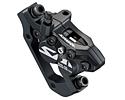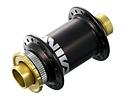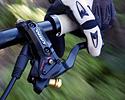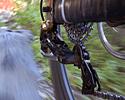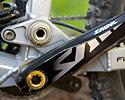
Recently on Cyclingnews.com |
Tech feature: Shimano Saint first ride, June 23, 2008
Flying high with the new Shimano Saint
By James Huang in Whistler, Canada
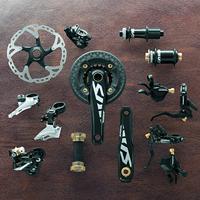
|
Shimano's newest range of Saint componentry follows the lead set forth by its XTR M970 cousin, offering a wider range of options and configurations in hopes of appealing to a more diverse range of riders. Even so, Shimano identified several key competencies that had to be maintained, namely durability, light weight and rigidity.
After much hype, we finally had our chance to sample the new gear in person and headed to the brutal proving grounds of Whistler's mountain bike park for a few days of downhill beatings to get an idea of how well Shimano's engineers did their jobs. Thankfully, it seems that Shimano paid some overtime.
Brakes we could only have dreamed of not long ago
While there are certainly a number of areas we could choose to highlight, the new brakes are arguably the shining star of the group. The new four-piston calipers deliver awesome power when you need it but, in typical Shimano fashion, are also virtually unmatched in terms of control and modulation. The power comes on smoothly and progressively and we experienced no chatter or fade, even on the longest runs (although the terrain admittedly fostered frequent brake checking instead of sustained braking). We didn't have the opportunity to give it a go in wet conditions but expect that the included sintered metallic pads should handle it just fine.
The new Servo Wave-equipped levers have superb feel, too, with a positive engagement point and reassuringly solid-feeling aluminum blades that have just the right hook at the end for proper one-finger braking. The tool-free reach adjustment was handy (although we only used it during initial setup) but lever travel, even in the shortest 'Free Throw' setting, was still a bit long for our liking. The throw can apparently be reduced via a little bleed trickery but we'd rather see Shimano offer a wider and more useful adjustment range here. Unfortunately, riders who prefer a close reach and particularly short throw might have to adjust their expectations a little here.
On the plus side, the deep-section aluminum spiders on the new rotors are markedly less prone to flex (especially as compared to all-steel discs): there's less vibration, less noise and less chance of bending if you inadvertently knock into something. As usual, the Center Lock design is ultra-easy and quick to install (or remove for shipping) and the oversized front lockring now uses a standard external-type bottom bracket tool.
Push, push, shift, shift
Our single-ring test setup meant that we only sampled the rear shifting on this newest round of Saint but we liked the results nonetheless. In marked contrast to Shimano's usual 'Light Action' feel, shift lever action was noticeably more positive for better tactile and audible feedback when you're bouncing like a pinball down the trail.
The stubby levers sit out of the way but are still easily accessible when needed and the new thumb-or-forefinger 2-Way shift actuation should accommodate most rider preferences. Some riders may be a little disappointed that Shimano didn't include its Multi-Release feature to ease multiple upshifts but it's an understandable omission. In rough conditions it's all too easy to shift more gears than you want with Multi-Release and it's still plenty easy to rattle off a bunch of gears if need be.
Shimano readily admits that it saved quite a bit of weight on the new Shadow-style rear derailleur but lost some of the durability that came from the old model's axle-mounted system. That may be true, but the low-profile design is also better shielded from impact in the first place and still quite beefy. Luckily, we never got the chance to actually test the derailleur's impact strength firsthand but a manual 'flex test' and the derailleur's skidplate-like design at least offers a reassuring sense of solidity.
Most importantly, the combination flat-out works, and very well at that. After setting the intriguing mode converter to more closely track our relatively tight SLX cassette, we never missed a shift over three days and countless runs. On the downside, there is a bit of clunking coming from the derailleur body on bigger landings but the noise was admittedly quite muted overall and far from objectionable. Also, the little mode converter widget that we had to remove to accommodate the tight-ratio cassette is rather tiny and requires two even-tinier bolts. It'd be nice if Shimano changed this to something akin to a flip-flop arrangement as we'd virtually guarantee that we won't be able to find the thing if we ever decide to swap to a more all-mountain-friendly cluster.
A different kind of stable platform
The new Saint cranks made no apologies for their tremendously proportioned size that dwarfs that of Shimano's more cross country-oriented models. Their rigid shape is undoubtedly great for pedaling efficiency but in our case, we found the biggest benefit on some of Whistler's biggest landings which were greeted with a fantastically firm and flex-free platform. Steel pedal inserts aid in this department, too, and also make it far less likely that you'll rip out any threads.
For riders that plan on pedaling up as well as down, the two-chainring model's 36/22T combination strikes as offering a reasonably useful range.
So what didn't we like?
As it turns out, not much as any deficiencies in the new Saint are few and far between save for the handful we've already mentioned. To put it plainly, the new Saint componentry is simply so thoroughly competent in its performance that we found ourselves paying less and less attention to it the more we used it. And in this environment, that's about as much as you could ask for.
About the only thing we do wish for, though, is a complete wheelset to fill in the last piece of the puzzle. While we're definitely big fans of traditional hand-built wheels, Shimano has demonstrated an excellent ability to craft surprisingly lightweight wheels that are often stiffer and more durable than most other competitors in their weight class and we'd be curious to see what they could cook up here as well.
For sure, three days of runs is far from a proper long-term test period and the durability of key items, such as the new faster-engaging freehub body, will remain to be seen. We'll continue to beat on this stuff as best we can and will report back with anything noteworthy and we'll also see about getting our hands on the two-ring setup, too. In the meantime, though, it's all (mostly) downhill from here.
Photography
For a thumbnail gallery of these images, click here
Images by Shimano
- Shimano's newest Saint group offers lighter weight and more stiffness.
- The new two-chainring cranks feature a versatile 36/22T gear range.
- Bottom brackets are available to fit every major size.
- Brake levers are Servo Wave-equipped for fast pad engagement and excellent modulation.
- Calipers now have four pistons instead of last year's two.
- Stubby levers on the new shifters keep them out of the way when they're not needed. A two-position clamp offers a wide range of positioning flexibility.
- The new rear derailleur is no longer axle-mounted but should still be plenty durable thanks to its stout construction and steel mounting bolt.
- Shimano will offer Saint with an optional double-specific front derailleur.
- Naturally, the front derailleur be offered in both high-clamp and low-clamp variants. No word yet on a direct mount style, though.
- The 2009 freehub body engages faster for better pedaling response.
- The revised 20mm thru-axle front hub still uses an oversized lockring but not you can use a standard external-type bottom bracket tool to tighten it down.
Images by Sterling Lorence
- The brakes are likely the highlight of the group with tons of power and simply superb modulation and feel.
- The new levers feel great in your hands…
- …but the lever throw is a bit long even in its shortest setting for our liking.
- A new 'mode converter' feature means that the derailleur is better able to track the cogs on smaller cassettes than before.
- The beefy arms are noticeably flex-free on hard landings.
- Steel inserts help keep the pedals screwed in where they belong.
- The rear derailleur loses the solidity that came from being mounted directly to the axle but the Shadow design should help keep it tucked out of harm's way.
- Whistler's mountain bike park is an international destination and it doesn't take long to realize why.
- Climbing? What climbing?
- Whistler mountain is a natural habitat for lots of bears. Best to keep your distance here, folks.
- Buffed trails offer fast bermed corners and perfectly sculpted lips and transitions if you want them.
- The new cranks' stiffness is most noticeable on hard landings as Andrew Shandro kindly demonstrates here.
- Brake modulation is a key feature to have when you find yourself in this situation.
- How high do you want to go?
- The man with the plan. Shimano Saint product manager Hideki Ikemoto can walk the walk as well as he can talk the talk.

